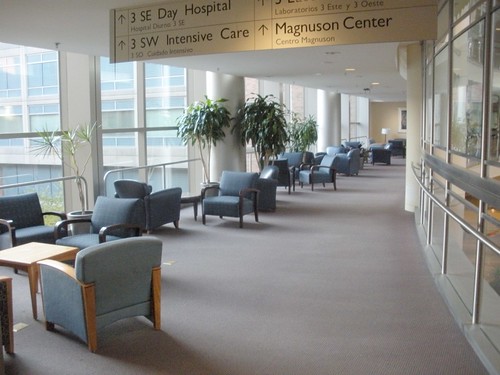Day 5 of the NIH Campath trial is going to result in a pretty boring report:
No chills.
No shakes.
No fever.
In other words,
things are going just about according to plan. Thursday was my third full dose of the drug, and my body has evidently reconciled itself to the fact that I will be pumping poison into it on a regular basis for a while.
The counts are looking pretty good. The lymphocytes, our target, have taken another blow, and are now down to 0.02K/uL (i.e., 20 per microliter). Meanwhile, the neutrophils are putting up a good fight and managed to stay over 1,000, at 1,200 per uL. That's still a comfortable distance from the 500 threshold that will put me on Cipro and a neutropenic diet.
After taking some big hits, platelets only dropped from 35,000 to 30,000 today; transfusion target is 10,000.
Hgb is at 8.2, portending an RBC transfusion in the next couple of days -- to be expected in this protocol.
Why don't patients talk with each other?
Since my results are pleasantly predictable, let me share some thoughts on another aspect of this place.
One of the really neat things about the Clinical Center at NIH is the number of bright open spaces left throughout newer portion of the building -- the Hatfield Center, completed in 2004. Those sun-filled lobbies are everywhere, with all manner of comfortable, upholstered seating -- from sofas to side chairs and recliners. There are even study carrels like those in a college library. There are also plenty of well-appointed small waiting rooms, big enough for four or five folks to have some privacy.
 DSCN4790
DSCN4790 by
hankins.greg, on Flickr
It seems to be part of a grand design to get patients up, dressed, and out of their standard-issue hospital rooms, meeting and chatting with other patients -- thereby accelerating the healing process.
It's a wonderful idea . . . which doesn't really seem to work. Most of that upholstered furniture seems to remain empty most of the time.
Why is that?
Some patients, of course, are just too sick to leave their rooms. They feel seriously crummy and really do want to lie in bed all day. In the hematology/oncology unit, some folks are recently neutropenic, and have been made paranoid (perhaps usefully so) by the nurse's explanation of what that means. So they are cowering in their rooms until they get over the shock and can face the world in a face mask.
But a lot of the problem is that the day-to-day operational mechanics of life in the hospital haven't caught up with the architect's vision of that life. When it's time to check vitals or administer meds, nurses show up at your room and expect to find you there. When the doctor has news to impart or wants to check up on you, he drops by the room and expects to find you there.
 DSCN4795
DSCN4795 by
hankins.greg, on Flickr
If you want to speak with your nurse, typically your only option is to press a button on a device in your room in order to speak with a a disembodied voice who will call your nurse on a phone the nurse has in his pocket. You cannot, however, call that phone in your nurse's pocket directly.
If you want to speak with your doctor, you can either wait in your room 'til she comes around; or you can push the button to tell the disembodied voice to fetch your nurse and then tell him that you'd like to speak with the doctor so that the nurse can then work through whatever system he has (typically mysterious to the patient) to contact the doctor. Often that system seems to amount to waiting until the nurse happens to see the doctor on the floor, though the nurses here at the Clinical Center can use a text paging service to send the doc some detailed info about who wants to see him and why. The doc will then drop by your room at some random time, expecting to find you there.
In short, if you want medical care, you have to stay in your room.
The net effect of all this is to keep patients in their rooms, instead of out in the nice comfortable lobby furniture that the architects felt would help keep patient's lives more normal, helping them heal more quickly.
What's the solution?
I don't know for sure, but a big step forward would be to put the pagers on the patients. The devices don't have to be fancy; they can use the same sort of system now used in restaurants, so folks waiting for a table don't have to stand around clogging up the foyer. Put a button by the door for the nurse or doc to press. That sets off the pager; and the patient knows, when the pager goes off, that she has five minutes to be back at the room.
Even better, get the patient's cellphone number, crank it into the unit database, and let the nurse or doctor call the patient to answer a question or set up an appointment: "Hi Mr. Hankins, this is Dr. Klotz. I understand you wanted to see me. I'll drop by your room about 3:30." I know most hospitals don't want you to use your cellphone, but everyone -- including the staff -- seems to do it anyway.
The NIH Clinical Center staff are actually pretty good at doing some things to make patients' lives more predictable -- like letting the patient know about the day's schedule in the morning, having a reliable schedule for rounds, and using text paging for the docs.
But all of that hasn't managed to get most patients out in the lobbies. If the lobbies make sense, it makes sense to take the next step and make it possible for patients to use them while at the same time getting good medical care.
What do y'all think?